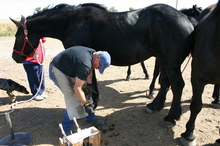Leading scientific researchers in the field of Equine Metabolic Syndrome (EMS) gathered in Boston in September under the direction of Dr. Nicholas Frank, Professor and Chair of the Department of Clinical Sciences in Large Animal Internal Medicine of the Cummings School of Veterinary Medicine at Tufts University. I had the privilege of attending this meeting, which was sponsored by Boehringer Ingelheim Vetmedica’s Equine Division.

Research into preventing laminitis in horses
The purpose of the conference and the goals of the research related to Equine Metabolic Syncrome and Cushing's Disease (PPID) as they relate to laminitis.
In a series of questions directed to Dr. Donald Walsh, founder of the Animal Health Foundation, the purpose of the conference and the goals of the research related to Equine Metabolic Syncrome and Cushing's Disease (PPID) as they relate to laminitis are summarized:
AHF: Why, with all the other conferences, would this meeting be needed?
Dr. Walsh: We met to discuss the latest research findings and to shape opinion regarding the future research most needed to prevent horses from developing this type of painful laminitis. These gatherings allow for researchers who may have only known someone as a name on a manuscript to meet and interact with each other on a very informal basis. Ideas are exchanged, questions asked, friendships made, and collaborations often occur.
AHF: Did you talk only about metabolic problems? What about laminitis?
Dr. Walsh: Although Equine Metabolic Syndrome (EMS) was the main subject, some time was delegated to hearing the latest information regarding PPID (Cushing’s Disease). Both conditions are extremely relevant to laminitis, since so many affected horses develop laminitis. To understand this type of laminitis, research is exploring endocrine (hormonal) processes that may initiate laminitis. While EMS and PPID were the area of great interest this year, the Summit previously also covered other endocrine disorders.
AHF: What does this group hope to achieve?
Dr. Walsh: The general direction and driving goal of the group is to find ways to diagnose both EMS and PPID earlier, before horses develop the crippling disease laminitis.
AHF: What was this meeting's most important new development relevant to the Animal Health Foundation's interest in laminitis research?
Dr. Walsh: One of the most widely agreed upon ideas, regarding a diagnosis of EMS, was the use of a test to reveal an abnormally large insulin and/or glucose response seen in the blood measured 75 minutes after an oral dose of sugar is given.
Those horses and ponies that test positive are at high risk of developing laminitis and will require special husbandry practices and, in some cases, drugs to maintain normal levels of insulin and normal feet. AHF is integrally involved in this research project (see upcoming article on AHF website) with Dr. Nick Frank at Tufts University.
AHF: What does this mean to our horses that are at risk for EMS-type laminitis?
Dr. Walsh: I can imagine that, in the near future, we might include an oral sugar test as part of the annual physical exam. It might work like this: the owner gives the horse two ounces of common household Karo syrup before the veterinarian arrives. Then the veterinarian takes a blood sample 75 minutes later to test the insulin and glucose levels. If the horse has any symptoms of PPID (Cushing’s Disease), a test for ACTH can also be done.
AHF: How does that relate to laminitis?
Dr. Walsh: We know that both EMS and PPID can result in laminitis. The changes start to occur when insulin levels are elevated for a prolonged time, causing alterations in the growth pattern of the foot. This results in abnormal rings on the external hoof capsule and a separation in the hoof wall at the toe, when seen from the bottom of the foot. Early recognition and correction of the insulin level is essential to prevent laminitis.
About the Animal Health Foundation:
The Animal Health Foundation has provided financial support for international laminitis research for more than 20 years. Many major breakthroughs in the understanding of the disease have been accomplished with AHF funding by researchers at the Australian Equine Laminitis Research Unit (University of Queensland), University of Missouri College of Veterinary Medicine, and Cornell University, as well as by independent professional researchers like forage specialist Kathryn Watts of safergrass.org.
Research funded by the all-volunteer, not-for-profit organization, is provided by individual donors from throughout the United States, many of whom are horse owners, veterinarians and farriers who struggle with the disease and want to see research advance.
AHF is dedicated exclusively to funding laminitis research and to educating people about the disease.
Visit http://www.ahf-laminitis.org/p/donate.html to make a direct donation.
The Animal Health Foundation hosts an educational YouTube channel with videos covering the types and phases of laminitis, with information for horse owners, veterinarians and farriers.
To learn more:
Animal Health Foundation web site and news blog http://www.ahf-laminitis.org Equine Endocrinology Summit: Laminitis Research Questions and Answers
from The Animal Health Foundation
Summary: Dr. Donald Walsh, founder of the Animal Health Foundation helps us find out why research into equine endocrine problems is critical to understanding why, how, when and if horses get laminitis. The Animal Health Foundation is a grassroots, all-volunteer organization that is solely dedicated to funding laminitis research at leading research centers around the world.
